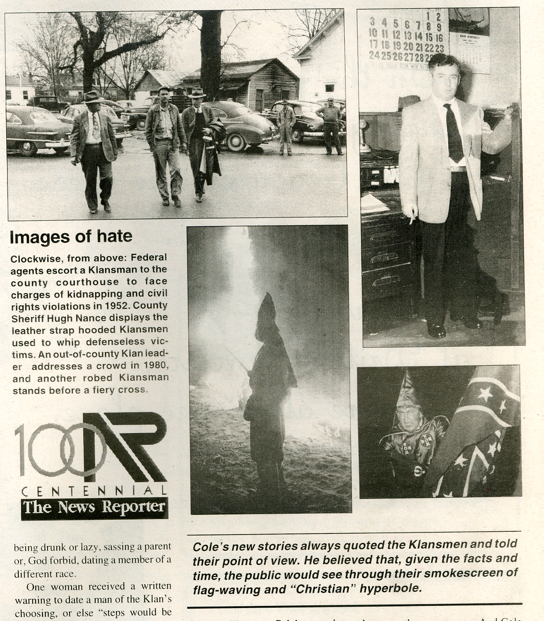Back to the Future

©
Whiteville News Reporter
images from the Pulitzer Prize-winning
articles on the KKK
Inspired by what he had heard at the workshop, High and his sister in early June 2014 met in the News Reporter’s small, windowless conference room that doubled as the library, or “morgue,” to decide jointly on a path forward. They were surrounded by bound, yellowed copies of the paper that dated back more than a century, including the Pulitzer-Prize-winning articles on the KKK published by their grandfather in the early 1950s. Their goal: map out a strategy for the coming year.
L. High had earlier rejected as premature some of the recommendations from the UNC team for cutting costs and increasing revenue by 30 percent over a five-year period. But now he was ready to reconsider.
Shed legacy printing and distribution costs. Both the News Reporter’s offset press, purchased in 1974, and its production employees were aging. Recently, one of the pressmen, age 64, had collapsed at work and had to be rushed to the hospital. The person in charge of the mailroom was 70. Jim High had resisted outsourcing print and distribution because it meant laying off lifelong employees. However, the current production operation was barely breaking even. If a major press component broke (requiring a “six-figure repair”), or if the paper lost just one outside printing contract, L. High calculated that the paper would have to outsource printing immediately. Since 2009, most newspapers in eastern North Carolina had outsourced printing to one of two regional newspapers (50-150 miles away) that had state-of-the-art presses working 24/7. Perhaps the paper could improve profits if it did the same. “Should we wait for the emergency or bite the bullet now?” asks High.
Create more print and digital publications around special interests, such as parenting. The prototype for the Plugged-In Parenting section was “ready for primetime” but its two biggest proponents had left the paper. Meanwhile, two summer interns—both journalism majors—and his 17-year-old daughter were lobbying Les High to start an online-only section of “news for people who aren’t old.” With S. High, they had produced a prototype dubbed “POP” (Popular Culture, Opinion and People). Several local businesses had expressed interest in sponsoring the online-only section aimed at readers aged 15-25. The Highs debated whether to “go where the staff energy and excitement are” (POP) and attempt to attract a young, wired audience, or follow the strategic plan and produce the print-and-online “Plugged-in Parents” section, which would likely attract a larger, older audience and more advertising revenue. If they opted to go with POP, how could the paper sustain it when the interns returned to school?
Pursue new sources of advertising revenue. “Sports of All Sorts” and 954 had been successful, producing enough revenue to more than offset costs, and repositioning the News Reporter as a multi-platform publication. But the Highs knew that they needed to continue to diversify away from print advertising, which still accounted for the vast majority of revenue. Preliminary research at UNC had concluded that newspapers had the potential to triple digital advertising revenue by establishing in-house advertising agencies that served all of their clients’ marketing needs (digital, print and video). [20]
The siblings had been intrigued by the success of the digital agency established at the much larger Santa Rosa Press Democrat. Could a slimmed-down model work in rural, economically challenged Columbus County? Was this the most efficient use of the three-person News Reporter advertising staff or would it overwhelm them? Was it better to increase digital revenue by launching multiple print and online products, as the Southern Pines Pilot had done? The two Highs realized that these were not “incremental steps” but a strategic reorientation. Were they ready? Could they tackle all three options simultaneously? Could they afford not to?
[20] Research conducted by JoAnn Sciarrino, Knight Chair of Digital Advertising and Marketing, UNC at Chapel Hill, in spring and summer 2014, with anticipated publication in spring 2015.